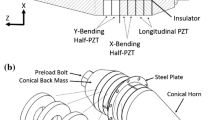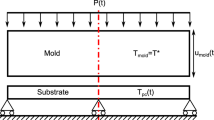Abstract
The focus of the paper is dynamic investigation and practical application of two different vibroactive pads: concentrator type vibroactive pad and vibroactive pad with spring, whose purpose is improve the quality of microstructure, created by the method of hot imprint. The goal is to find out operating frequencies of vibroactive pads, where the entire operating surface vibrates with equal displacements, since only then even impact of vibration excitation for microstructure could be obtained. Three types of investigation are employed during the vibroactive pads analysis: numerical simulation by using Comsol Multiphysics 3.5a. software static analysis and piezo solid frequency response modes, in order to find out whether the constructions are capable to vibrate at desired mode; after numerical simulation experimental analysis with holographic interferometry system PRISM is performed, in order to experimentally spot at this vibration mode; and finally vibrometer Polytec is being used to find out the amplitudes of vibration and in the same time to make sure, that vibroactive pads develop the same mode under hot imprint experimental conditions, i.e. when particular mechanical load is applied. Finally experiments of mechanical hot imprint are performed in order to see how newly created vibroactive pads are suitable for the process. The novelty of the paper is that the devices are being numerically and experimentally analysed, when they are under the action of mechanical load, this provides more accuracy to analysis and its results, allows avoid presumptions, based only on numerical simulation with applied mechanical load.

















Similar content being viewed by others
References
Figura J (2013) Modeling and control of piezoelectric microactuators. Bachelor thesis, Prague
Goldfarb M, Celanovic N (1997) Modeling piezoelectric stack actuators for control of micromanipulation. Control Syst IEEE 17:69–79
Heckele M, Schomburg WK (2004) Review on micro molding of thermoplastic polymers. J Micromech Microeng 14:1–14
Hirai Y, Yoshida S, Takagi N (2003) Defect analysis in thermal nanoimprint lithography. J Vac Sci Technol B 21(6):2765–2770
Jaszewski RW et al (1998) Hot embossing in polymers as a direct way to pattern resist. Microelectron Eng 41–42:575–578
Krauss PR, Chou SY (1997) Nano-compact disks with 400 Gbit/in2 storage density fabricated using nanoimprint lithography and read with proximal probe. Appl Phys Lett 71:3174–3176
Lee LJ et al (2001) Design and fabrication of CD-like microfluidic platforms for diagnostics: polymer based microfabrication. Biomed Microdevices 3(4):339–351
Li JM, Liu C, Peng J (2008) Effect of hot embossing process parameters on polymer flow and microchannel accuracy produced without vacuum. J Mater Process Technol 207:163–171
Lin CR, Chen RH, Chen CH (2003) Preventing non-uniform shrinkage in ope-die hot embossing of PMMA microstructures. J Mater Process Technol 140:173–178
Liu JS, Dung YT (2005) Hot embossing precise structure onto plastic plates by ultrasonic vibration. Polym Eng Sci 45:915–925. doi:10.1002/pen.20357
Liu C et al (2010) Deformation behavior of solid polymer during hot embossing process. Microelectron Eng 87:200–207. doi:10.1016/j.mee.2009.07.014
Mekaru H, Goto H, Takahashi M (2007) Development of ultrasonic micro hot embossing technology. Microelectron Eng 84:1282–1287. doi:10.5772/8191
Narijauskaitė B et al (2011) High-frequency excitation for thermal imprint of microstructures into a polymer. Exp Tech (published online 11 April 2011). doi:10.1111/j.1747-1567.2011.00724.x/
Narijauskaitė B, Palevičius A, Narmontas P, Ragulskis M, Janušas G (2013a) High-frequency excitation for thermal imprint of microstructures into a polymer. Exp Tech 37(5):41–47. doi:10.1111/j.1747-1567.2011.00724.x
Narijauskaitė B, Palevičius A, Janušas G, Šakalys R (2013b) Numerical investigation of dynamical properties of vibroactive pad during hot imprint process. J Vibroeng 15:1983–1992. ISSN 1392-8716
Palevičius A et al (2008) Digital holography for analysis of mechatronic systems. In: Proceedings of the 7th international conference vibroengineering 2008, October 9–11, Kaunas, Lithuania, pp 78–82
Popov E (2012) Gratings: theory and numeric applications. Institut Fresnel, Université d’Aix Marseille, CNRS. 1st edn. Presses Universitaires de Provence (PUP)
Sackmann J, Burlage K, Gerhardy C, Memering B, Liao S, Schomburg W K (2015) Review on ultrasonic fabrication of polymer micro devices. Ultrasonics 56:189–200. doi:10.1016/j.ultras.2014.08.007. ISSN: 0041-624X
Šakalys R, Janušas G, Palevičius A, Bendikienė R, Palevičius R (2015) Microstructure replication using high frequency vibroactive pad. Mechanika 21(2):5–12. ISSN 1392-1207
Yao DG, Vinayshankar LV, Byung K (2005) Study on sequeezing flow during nonisothermal embossing of polymer microstructure. J Polym Eng Sci 45:652–660
Acknowledgments
This research was funded by a Grant (No. MIP-026/2014) from the Research Council of Lithuania.
Author information
Authors and Affiliations
Corresponding author
Rights and permissions
About this article
Cite this article
Šakalys, R., Janušas, G., Palevičius, A. et al. Microstructures replication using high frequency excitation. Microsyst Technol 22, 1831–1843 (2016). https://doi.org/10.1007/s00542-016-2858-7
Received:
Accepted:
Published:
Issue Date:
DOI: https://doi.org/10.1007/s00542-016-2858-7




